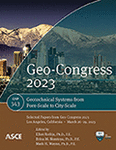Pre-Failure to Post-Failure Behavioral Spectrum of Jointed Rock Slopes
Publication: Geo-Congress 2023
ABSTRACT
The whole behavioral spectrum of jointed rock slopes should be investigated to analyze the stability and post-failure state of these geostructures that host a variety of civil infrastructure. This study aims at understanding the mechanical behavior of jointed rock slopes, which emerges from the interaction between the newly generated fractures and the complex network of pre-existing fractures. We use a hybrid finite-discrete element method to analyze the failure and post-failure states of several jointed rock slope models with different joint patterns. The initial failure is triggered by a strength reduction mechanism. This method of analysis can indicate the failure mechanism and other important parameters for the analysis and design of sustainable and resilient infrastructure surrounding the slopes. These important parameters include, for example, the runout distance and volume, and the kinetic energy of the failed materials. The results show that jointed rock geostructures do not have a single factor of safety. This is because the contributions of the rock matrix and discrete fracture network in the failure mechanism and extent of these structures are different and depend on their initial and evolving properties with the given environmental perturbations.
Get full access to this article
View all available purchase options and get full access to this chapter.
REFERENCES
Bar, N., and Barton, N. (2017). “The Q-Slope Method for Rock Slope Engineering.” Rock Mech Rock Eng., 50, 3307–3322.
Barton, N., and Bandis, S. (1982). Effects of block size on the shear behavior of jointed rocks. The 23rd U.S Symposium on Rock Mechanics (USRMS), Berkeley, California, August 25, ARMA-82-739.
Barton, N., Bandis, S., and Bakhtar, K. (1985). “Strength, deformation and conductivity coupling of rock joints.” International Journal of Rock Mechanics and Mining Sciences, Geomechanics Abstracts, 22(3),121–140.
Barton, N., and Quadros, E. (2015). “Anisotropy is everywhere, to see, to measure and to model.” Rock Mech Rock Eng., 48,1323–1339.
Blair, S. C., and Cook, N. G. W. (1998). “Analysis of Compressive Fracture in Rock Using Statistical Techniques: Part II. Effect of Microscale Heterogeneity on Macroscopic Deformation.” Int. J. Rock Mech. Min. Sci., 35(7), pp. 849–861.
Cundall, P. A., and Hart, R. D. (1992). “Numerical modelling of discontinua.” Engineering Computations, 9(10), 1–13.
Damjanac, B., Detournay, C., and Cundall, P. A. (2015). “Application of particle and lattice codes to simulation of hydraulic fracturing.” Computational Particle Mechanics, 1–13.
Gao, F. Q., and Stead, D. (2014). “The application of a modified voronoi logic to brittle fracture modelling at the laboratory and field scale.” Int. J. Rock Mech. Min. Sci., 68 (68), 1–14.
Geomechanica Inc. (2021). Irazu Software: Theory Manual. Toronto, Canada.
Goodman, R. E., and Bray, J. W. (1977). “Toppling of rock slopes.” Rock Engineering for Foundations & Slopes, ASCE 201–234.
Goodman, R. E., and Taylor, R. L. (1968). “A Model for the Mechanics of Jointed Rock.” Journal of the Soil Mechanics and Foundations Division, SM3, 637–659.
Huang, Y. (2014). Slope Stability Analysis by the Limit Equilibrium Method: Fundamentals and Methods. ASCE Press.
Jing, L. (2003). “A review of techniques, advances and outstanding issues in numerical modelling for rock mechanics and rock engineering.” International Journal of Rock Mechanics & Mining Sciences, 40, 283–353.
Kliche, C. A. (2019). Rock Slope Stability, 2nd Edition, Society for Mining, Metallurgy, and Exploration.
Lisjak, A., and Grasselli, G. (2014). “A review of discrete modeling techniques for fracturing processes in discontinuous rock masses.” Journal of Rock Mechanics and Geotechnical Engineering, 6, 301–314.
Lisjak, A., Kaifosh, P., He, L., Tatone, B. S. A., Mahabadi, O. K., and Grasselli, G. (2017). “A 2D, Fully-coupled, hydromechanical, FDEM formulation for modeling fracturing processes in discontinuous, porous masses.” Computers and Geotechnics, 81, 1–18.
Moallemi, S., Yee, T., Qi, D., Yacoub, T., Corkum, B., and Curran, J. H. (2022). On the use of Extended Finite Element Method (XFEM) for jointed rock slope problems. In: The Evolution of Geotech - 25 Years of Innovation – Hammah et al. (Eds).
Munjiza, A., and Andrews, K. R. F. (2000). Penalty function method for combined finite-discrete element systems comprising a large number of separate bodies. International Journal of Numerical Methods in Engineering, 49, 1377–1396.
Zheng, Y., Chen, C., Liu, T., Zhang, H., Xia, K., and Liu, F. (2018). “Study on the mechanisms of flexural toppling failure in anti-inclined rock slopes using numerical and limit equilibrium models.” Engineering Geology, 237, 116–128.
Information & Authors
Information
Published In
History
Published online: Mar 23, 2023
Authors
Metrics & Citations
Metrics
Citations
Download citation
If you have the appropriate software installed, you can download article citation data to the citation manager of your choice. Simply select your manager software from the list below and click Download.
